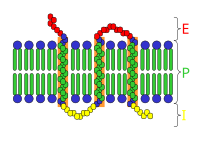
Photo from wikipedia
Microsporidia are obligate intracellular parasites that can infect a wide range of vertebrates and invertebrates including humans and insects, such as silkworm and bees. The microsporidium Nosema bombycis can cause… Click to show full abstract
Microsporidia are obligate intracellular parasites that can infect a wide range of vertebrates and invertebrates including humans and insects, such as silkworm and bees. The microsporidium Nosema bombycis can cause pebrine in Bombyx mori, which is the most destructive disease in the sericulture industry. Although membrane proteins are involved in a wide range of cellular functions and part of many important metabolic pathways, there are rare reports about the membrane proteins of microsporidia up to now. We screened a putative membrane protein Ycf 1 from the midgut transcriptome of the N. bombycis-infected silkworm. Gene cloning and bioinformatics analysis showed that the Ycf 1 gene contains a complete open reading frame (ORF) of 969 bp in length encoding a 322 amino acid polypeptide that has one signal peptide and one transmembrane domain. Indirect immunofluorescence results showed that Ycf 1 protein is distributed on the plasma membrane. Expression pattern analysis showed that the Ycf 1 gene expressed in all developmental stages of N. bombycis. Knockdown of the Ycf 1 gene by RNAi effectively inhibited the proliferation of N. bombycis. These results indicated that Ycf 1 is a membrane protein and plays an important role in the life cycle of N. bombycis.
Journal Title: PeerJ
Year Published: 2022
Link to full text (if available)
Share on Social Media: Sign Up to like & get
recommendations!